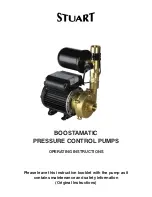
WIK USER INSTRUCTIONS ENGLISH BO2662 5/09
Page 34 of 76
5.6
Priming and auxiliary supplies
Ensure all electrical, hydraulic,
pneumatic, sealant and lubrication systems (as
applicable) are connected and operational.
Ensure the Inlet pipe and pump
casing are completely full of liquid before starting
continuous duty operation.
5.7
Starting the pump
When in the vicinity of caustic, corrosive,
volatile, flammable, hot, cold, or otherwise
hazardous liquids, wear protective clothing that
is compliant with your organization's local safety
procedures. When in the vicinity of toxic liquids
or vapors, wear breathing protection that is
compliant with your organization's local safety
procedures. Do not allow sparking, flames, or
hot surfaces in the vicinity of equipment that
handles volatile or flammable liquids.
All pressure, temperature, and flow
requirements listed in this section are defined in one
of the following, unless otherwise specified in
section 10.3 of this manual, Flowserve Engineering
drawings in back of this manual, or in your plant data
file.
Place the pump in operation using the following task
sequence:
1) Ensure:
a) That driver and gear (if applicable) have
been serviced and are ready for start-up as
required under section 5.1.1 above
b) That requirements for pumps and auxiliary
systems under section 5.1.2 have been met
c) That auxiliary or spare lube oil pump is
operating
d) That the pump discharge valve is in bypass,
if your pump is so equipped
In order to ensure adequate
lubrication of interior parts of the pump, sufficient
pressure differential must be generated so there will
be a nominal flow of pumpage across running
clearances; therefore it is essential that the pump be
operated above minimum governor speed of a
turbine driver.
2) Start driver (see manufacturer's instructions in
Section 10 for starting driver).
A sudden drop in discharge pressure
usually means a failure in the system supplying
liquid to the pump and vaporization of liquid inside
the pump. Once the pump is shut down and rotation
stops, it may be restarted after the vapor is cleared
by opening the vent line. If normal discharge
pressure is established immediately on restart, the
pump is clear of vapor, and normal operation may
be continued. If discharge pressure is not
established immediately, again shut down the unit
and determine the cause.
3) Slowly begin to open discharge valve as soon as
pump reaches full speed and pressure (within a
few seconds). (A slow opening avoids abrupt
surging in suction and discharge lines.)
Immediately shut down pump if:
a) Pump begins to run rough or vibrate
b) Temperature of lube oil entering thrust
bearing exceeds maximum allowed
c) Discharge pressure drops suddenly
d) Circulation of cooling water for heat
exchangers or seal housing stops
e) Lube oil pressure drops to zero
f) Circulation of seal flushing liquid stops
g) Clutch malfunctions
4) Check pressure gauge that is located in lube oil
system instrument panel (see lube oil schematic
drawing). Gauge should read pressure of lube
oil as given on lube oil schematic drawing and
auxiliary or spare lube oil pump should shut
down. If spare lube oil pump does not shut down,
then shut it down. Then if lube oil pressure drops
off, immediately shut down pump and
troubleshoot lube oil system (see section 7).
5) Close off vent valves and valves in warm-up
circuit.
6) See that injection of flushing liquid to seals is
adequate to avoid damage to pump and seals.
7) Check for leakage around shaft, at seal
housings, and at bearing housings. Mechanical
seals and bearing housings should not show
leakage.
8) See that cooling water to heat exchangers and
seal housings is adequate.
Changes in ambient or cooling water
temperature may require cooling water flow to the
lube oil cooler to be increased to maintain lube oil
temperatures in accordance with the lube oil
schematic drawing.
















































